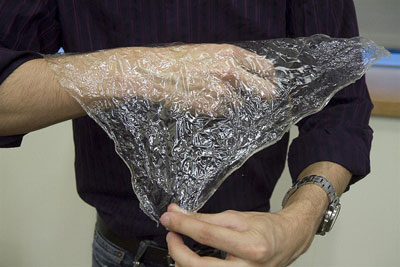Shrilk: Nature’s New Bioplastic
By Ansel Oommen
22 July, 2013
Countercurrents.org
 Since their inception after World War II, synthetic plastics have left an indelible mark on society. From cars, computers, and appliances, to textiles, packaging, and home insulation, their usage has only been surpassed by their notorious effect on the environment.
Since their inception after World War II, synthetic plastics have left an indelible mark on society. From cars, computers, and appliances, to textiles, packaging, and home insulation, their usage has only been surpassed by their notorious effect on the environment.
According to the U.S. National Park Service, plastic bottles can take up to 450 years to decompose. While they do indeed break down, plastics are not truly biodegradable. Instead, they accumulate in landfills and oceans, leaching chemicals and killing wildlife. Several plastics, including polyvinyl chloride, phthalates, and Bisphenol A, have been linked to endocrine disorders, cancers, and birth defects.
But researchers from Harvard University have created a new alternative . Javier Fernandez and Donald Ingber of Harvard’s Wyss Institute for Biologically Inspired Engineering have found their muse in the most successful of organisms: arthropods. Many invertebrates like crabs, beetles, and snails, are armored with cuticles that are not only strong, but flexible and light due to evolutionary pressures. As a result, they are a rich basis for natural plastics.
In an exceptional case of biomimicry, Fernandez and Ingber have developed a process that layers two common polymers together. Fibroin, one of the components, is a silk protein obtained from the domestic silkworm. The other, chitin, is derived from shrimp shells. The product, a composite of shrimp and silk, has been aptly coined shrilk.
The key ingredients of shrilk could not be any more ubiquitous, making the invention highly resourceful and economic. The boiled silkworm pupae, once a byproduct of silk extraction, have since become an important source of dietary protein. Chitin, a waste material of the shrimp industry, is given a valuable second life.
Both materials are then laminated into a unique molecular arrangement, imparting mechanical strength and durability.
“The process of layering shrilk is not chemical” Fernandez explains, “The original components (chitin and fibroin) have the same chemical composition before and after the process.”
In nature, the hardness of insect cuticles is determined by three major steps: dehydration, sclerotization, and molecular arrangement. Fernandez and Ingber have emulated the former and latter processes. The result: a material with the strength and toughness of aluminum alloy at half the weight. The new matrix is also hydrophilic, or water-loving, allowing for its mechanical properties to change depending on how much water is involved.
Unlike traditional plastics, shrilk is fully biodegradable. In fact, chitin is a great nitrogenous fertilizer and organic fungicide.
Because of its durable yet transient nature, shrilk may find future use in the biomedical field, where potential applications could include surgical sutures, gauzes, and as a scaffold for tissue implants where it provides initial support and soon disappears when the graft is successful. Amazingly, it can be molded into various complex shapes. Many more possibilities, for both internal and external treatments, are being explored.
Of course, cost is also a concern. Fernandez notes a cheaper version is currently under development.
As a bioplastic, shrilk has all the advantages of its traditional counterparts with none of the associated environmental risks.
“The plan is to replace synthetic plastics in plastic ware” hopes Fernandez. And in a world where six pack rings and plastics bags continue to poison our waters and defile our lands, that hope remains encouragingly strong.
Ansel Oommen is a freelance writer, journalist, and multimedia artist whose work has been featured in magazines such as Pacific Horticulture, First Things, Network Ireland and Organic New Zealand. Discover more and appreciate at http://www.behance.net/Ansel
Data was also taken from:
David Bradley. (2012). A cuticle new composite: Biomaterials. Materials Today, 15 (1-2): 8
Comments are moderated


